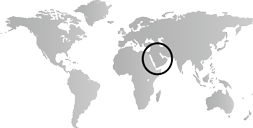Arabia had been under Ottoman rule since the sixteenth century. The seeds of the modern Saudi state in central Arabia are sown in 1744. The local ruler, Muhammad ibn Sa‘ud (1689–1765), joins forces with Islamic reformer and purist Muhammad ibn ‘Abd al-Wahhab (1703–1792) to create a new political entity. Throughout the nineteenth century, the fortunes of the Sa‘ud family rise and fall several times as the Saudi rulers contend with Egypt, the Ottoman empire, and other Arabian families for control of the peninsula. ‘Abdul ‘Aziz al-Sa‘ud (ca. 1880–1953) founds the modern Saudi state; in 1926, he becomes king of the Hejaz and Najd, and in 1932 these regions are unified as the Kingdom of Saudi Arabia. Meanwhile, Britain takes incremental control over many coastal areas in order to guarantee the safety of its boats carrying goods to India.
The Arabian Peninsula in the nineteenth century, however, remains an isolated and peripheral domain of the Ottoman empire—one virtually untouched by the cultural and artistic developments at Istanbul. Ottoman influence is seen only in the holy cities of Mecca and Medina, with the Ottoman restoration and enlargement of the Mosque of the Prophet and Haram Mosque. In the Arabian Peninsula and the Gulf countries, Western aesthetics and modern art training do not appear until the second half of the twentieth century.
During the nineteenth century, Iraq, Palestine (renamed the state of Israel in 1948), Jordan, Syria, and Cyprus are all part of the Ottoman empire. European powers, primarily the British and French, move into the region as the Ottoman grip loosens. As a result, Arab culture yields increasingly to Western art forms and styles. Lebanon is among the first Arab countries to adopt Western art, which infiltrates the country through European missionaries, who open convents and schools and introduce lithography and printing. The missionaries in Lebanon are responsible for establishing the basis for a cultural, social, and political life centered on Christianity, which leads to a flowering of art and culture and the evolution of the Gothic school of religious painting. In the 1860s, artists such as Ni‘matullah Allah al-Ma‘adi and Daoud Corm (1852–1930) are dispatched to Europe to study. The first Arab reaction against the Ottoman government is witnessed in this region at the end of the nineteenth century. It is initiated as a literary movement by the American Presbyterian Mission, which produces new school textbooks in Arabic rather than Turkish.
In Syria, the art of wall painting, modeled on those found in Anatolia, continues well into the nineteenth century, and the art of Christian church icons, painting on glass and on textiles flourishes. Syria experiences the first European influences through Ottoman art. European-inspired Ottoman decorative styles in wall painting begin to appear in the houses of Aleppo and Damascus. Meanwhile, local artists look to Western art and attempt to fuse it with native forms. By the late nineteenth century, Syrian notables and statesmen commission Western-style portraits and landscapes for display in their private residences.
Jordan, on the other hand, assimilates Ottoman artistic influence only in architecture. Hardly any other traces of Western art exist in the country in the nineteenth century. The beginnings of a modern art movement are not seen in Jordan until the 1920s and ’30s. In Iraq, modern Western art develops only at the end of the nineteenth century, after the reforms of the Ottoman wali (governor) Midhat Pasha (r. 1869–72). These include the creation of new cities, construction of new buildings, the opening of modern schools, printing presses, newspapers, hospitals, and the railway. The traditional arts of mural painting and painting on glass are practiced until the end of the nineteenth century. Oil painting is introduced into Iraq at the turn of the twentieth century by a group of officers who had received training at the military schools in Istanbul. They are responsible for launching a modern art movement in Iraq and paint much in the same manner as the Turkish soldier painters, paying close attention to naturalism, use of light and shade, and modeling. They also encourage students to paint from nature instead of copying from photographs.
Palestinian art remains impervious to the influences of Western art until 1948. During the nineteenth century, the traditional arts of embroidery, pottery, weaving, calligraphy, icon painting, wood engraving, stone carving, and mosaic represent the chief arts of Palestine. Meanwhile, throughout the region, the traditional arts persist alongside Western-inspired art during much of the nineteenth century.


